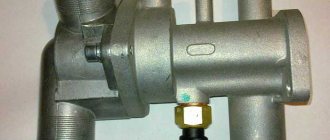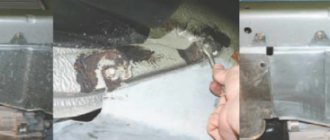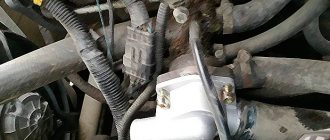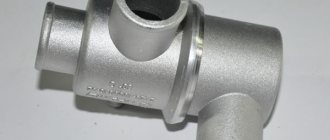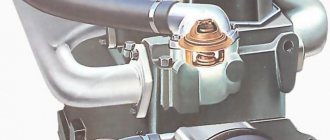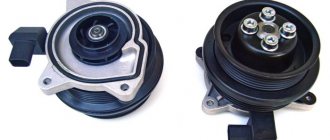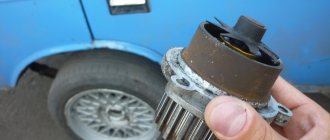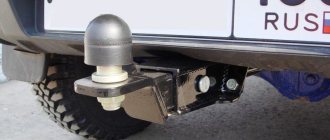The thermostat is an important element in the engine cooling system. It is responsible for warming up the engine during startup, as well as maintaining the temperature within normal limits. Replacing the VAZ 2114 thermostat is required if problems arise with long engine warm-up or boiling.
This video clearly demonstrates the process of replacing the thermostat on a VAZ 2114:
Let's figure out how to identify the malfunction of this part, how to change the thermostat with your own hands and what we need in the process of repairing the car.
Purpose, design and principle of operation of the thermostat
The coolant circulating through the working channels of the engine blocks, its main purpose is to remove excess heat accumulated in the power unit due to the friction of the working elements of the engine and the impact of the high temperature of the exhaust gases passing through the exhaust circuit.
The main elements of the cooling system of the VAZ 2114, which are responsible for lowering the temperature of the antifreeze, are the electric cooling radiator fan and the thermostat.
To understand the principle of its operation, you need to see what the thermostat on a VAZ 2114 looks like. Structurally, it is designed in such a way that the valve that regulates the coolant flow is located inside a housing with three pipes:
- two inputs - from the engine and radiator;
- one day off - to the pump.
Thermostat device VAZ 2114
The main working element of the valve itself, located inside the thermostat, is a solid heat-sensitive filler, which, when heated, through a rubber insert, acts on the piston that moves the main valve. When it heats up, it opens it, when it cools down, on the contrary, it closes the hole, preventing the flow of antifreeze.
The thermostat is attached to the engine through a pipe to the cylinder head on the left side, under the air filter. It is connected to the radiator and pump using rubber pipes. On a cold engine, the valve of this coolant flow regulator is closed and after starting, the liquid that begins to be pumped by the pump forces moves along a “small circuit” or “in a small circle.” Both of these expressions are used among motorists. When moving in a small circle, the antifreeze passes through the heater radiator, intake manifold and throttle assembly. Liquid is not supplied to the radiator; the valve cuts off this path.
As the engine heats up, the coolant takes away some of the heat, heats up and, passing in a “small circle” through the thermostat, heats the temperature-sensitive element. The piston begins to move and open the main valve. This begins to happen when the liquid temperature reaches 87 degrees. In this case, part of the coolant begins to circulate through the radiator. When the temperature reaches 102 degrees, the valve opens completely, moving eight millimeters. In this mode, the entire coolant flow rushes in a “large circle” through the cooling radiator.
Experts recommend checking the operation of the thermostat without removing it from the car. To do this, after starting the engine, you need to touch the lower pipes coming from the radiator with your hands. They should be cold until the temperature rises above eighty degrees. As soon as the temperature rises above 85 degrees, the tubes should begin to heat up and after a while you can feel that the “large circle” circulation is working. The tubes should get quite hot.
If the lower pipes leaving the radiator continue to remain cold, it means the main valve has not opened and the thermostat is faulty. A malfunction of this regulator may also be indicated by the fact that the lower tubes begin to heat up almost immediately after starting the engine. This indicates that the valve is open and does not close when cold.
In both cases, a thermostat failure does not bring anything good for the engine. In the case when the valve is open, the antifreeze, passing in a “large circle,” does not have the opportunity to heat up to working condition. This reduces engine power and other performance parameters. In the case when the main valve is closed, the engine has a high risk of overheating the blocks. This is the most dangerous condition for the power unit. If you drive in this mode for some, even not very long, time, you can damage the engine, even to the point of breaking the shafts. And this, at a minimum, is a major overhaul of the entire internal combustion engine.
There is a different way to check the thermostat on a VAZ 2114. To do this, you need to pour water into a pan and, placing it on the stove to heat, immerse the thermostat there. Knowing at what temperature the thermostat on the VAZ 2114 opens, use a thermometer to monitor the heating of the water in the pan. At about 87 degrees the valve should open. If this happens, then the device is fully operational. It is better to check it in this way before installing it in place of a failed one.
Many car enthusiasts often ask specialists whether it is possible to repair the thermostat.
If this does not happen, then the thermostat on the VAZ 2114 needs to be replaced.
Replacement or repair
Of course, it is possible to repair a broken device, but is it really that effective? If you consider the repair option, it is recommended that it be carried out exclusively in the field if you have the necessary tools. If the valve is not working, you can try to clean it in order to get to your destination. After this, it is recommended to immediately replace it.
The thermostat on the VAZ 2114 is a consumable item, the cost of which is not so high to try to repair it. Purchasing a new device guarantees its long service life, while a refurbished device may break down after just a few days. Therefore, in the event of a breakdown, it is recommended to install an analogue, even within 500 rubles, which can definitely last at least six months to a year.
Why install a Granta thermostat on a VAZ-2114?
Thermostat Lada Granta
Any adjustments that are made to the design and interior heating circuit of front-wheel drive VAZ cars are designed to either improve ventilation or improve heating and raise the temperature in the cabin in winter. Almost since the appearance of the first 2108, no changes were made to the cooling system and its architecture, which means that heating the interior remained ineffective.
With the advent of the modernized cooling system of the Lada Granta, the situation has changed for the better and here's why.
Cooling system VAZ-2114
If you look closely at the coolant circulation diagram in a Samara family car, it becomes clear why the heater radiator warms up last. The diagram shows that the cold (small) circle of the heating system does not include a heater radiator; more precisely, the heater radiator is connected in parallel, which certainly does not contribute to the rapid heating of the heater.
At the same time, we also take into account the ability of thermostats to react incorrectly to temperature and leaks in the air ducts, so until the engine warms up and the large full circuit of the cooling system turns on, you can’t even dream of heat in the cabin.
Cooling system for Lada Granta
Nuances when upgrading the VAZ-2114 heater
Let us emphasize that the need to install a thermostat from Granta on the VAZ-2114 and other cars of the Samara family is dictated by the poor performance of the standard stove with the same set of cooling system elements, excluding the thermostat.
Theoretically, the performance of the VAZ-2114 stove, like other Samaras, depends not only on the temperature of the antifreeze, but also on the number of revolutions of the pump, on the degree of its distance from the engine along the circuit, all this reduces the efficiency of its operation. If we successfully tune the stove, we will be able not to warm up the antifreeze in the expansion tank, not to heat it in the main radiator, but to immediately get maximum heat in the cabin.
What is needed to install a Grant thermostat?
If we are convinced that the stove is working very poorly due to an unsuccessful design, we will have to buy some additional elements of the cooling system:
- Grant thermostat with catalog number 21900-1306010-00. It costs about 700-800 rubles.
- New gasket for the thermostat housing.
- Two studs (or bolts, but studs are better) M8x85mm.
- Lower Grant radiator pipe.
- Return tee.
- Sealant, bolt-on clamps, coolant.
Everything should cost no more than 2.5 thousand rubles, but the heating system will work flawlessly. If everything is clear and purchased, we proceed to replacing the thermostat.
Where is? How to replace a thermostat
Before replacing the thermostat, you must clear access to it. For VAZ 2114 1.5 and 1.6 on 8-valve engines, the process may be slightly different, but generally identical. After the functionality test has been carried out, we proceed to dismantling.
First of all, to get to the device we need to remove the air filter housing. To do this, unscrew the bolts, loosen the clamps and remove the chip from the MAF sensor.
The difference between the 1.5 engine is that when removing it there is no need for a wrench; on 1.6 engines there are fasteners that can only be unscrewed using a hexagon.
After this, prepare a container for the coolant and drain it. If the car is equipped with engine protection, then it must also be removed.
At the bottom of the radiator there is a special tap that allows you to drain the coolant. We place a container under it and unscrew it, waiting for the coolant to completely drain. In order for it to flow out faster, unscrew the cap on the expansion tank.
After the liquid has drained, the air filter housing has been removed, and the pipes have been disconnected, you can remove the thermostat.
Replacement of the device is carried out in the reverse order. Before installing a new device, it is necessary to clean the seat and thoroughly coat it with sealant.
After the thermostat is installed on the VAZ 2114 injector, we fix the pipes in the reverse order.
Types of VAZ thermostats and which one is better
Visually, even an experienced salesman cannot distinguish a kopek thermostat from a Niv one. Because the difference is inside them and in the location of the pipes. All Togliatti thermostats are made according to the ancient Fiat design - they are removed from the cylinder head into a separate unit and fixed to the pipes and hoses of the cooling system. Here are the main types of VAZ thermostats:
All classic Zhigulis had a 2101 thermostat under the hood, which can be identified by the location of the pipes; they are turned opposite each other almost at a right angle
However, the most important difference is that the thermal operating conditions of rear-wheel drive Zhiguli engines required blocking the valve at 80 degrees and fully opening it at an antifreeze temperature of 95 degrees.
Exactly the same device was and is being installed on the Niva. The only difference is that the angle between the pipes tends to 180 degrees.
The eight thermostat is installed on all carburetor Samaras in their countless modifications
The difference with classic motors in terms of thermoregulation is that in thermostat 2108 the valve should operate seven degrees later. This happened due to the more advanced design of the combustion chamber, so until the antifreeze temperature reaches 87 degrees, the valve should be closed, and only at 102 degrees should it open.
Modern thermostats on the spare parts market are not distinguished by high accuracy and high quality workmanship, so after a series of tests the plant gave two degrees to the manufacturers. As a result, on boxes with thermostats for the entire Samara family, you can often see the number 85. Visually, the 2108 thermostat is distinguished by the presence of a thin pipe to remove possible air bubbles.
The tenth VAZ family received exactly the same thermostat housing as on the classic, but in a mirror image. It does not have a small pipe for air outlet, since the design for the carburetor tens provided a separate tee, which greatly complicated the decoupling of the hoses under the hood. By the way, the figure-eight device is also perfect for carburetor tens; the only thing you need to do is tightly plug the small air hole.
Such thermostats have become the most popular, so when purchasing them, you should definitely look inside; there should be a curtain made of plastic or metal, which better redistributes the flow of liquid to the thermoelement. If it is not there, the valve response temperature can differ greatly (up to 10-15 degrees) from the nominal value, which leads to overheating of the engine.
The thermostat of the 2112 family is designed specifically for injection VAZ engines. Actually, the thermostat doesn’t care what type of power system it is, it does its job and if the manufacturer is conscientious, the valve will always be closed up to a temperature of 85 degrees.
"Injection" thermostats
That is why in everyday life such thermostats are called “6-hole.” For this reason, such thermostats are optimal for all injection VAZ cars, including the VAZ-2114. This is exactly what they replace from Granta.
Determination of malfunction and list of new parts
It is quite easy to detect a faulty part when the engine starts to overheat, just touch the lower pipe on the radiator of the cooling system, and if it turns out to be not very hot, this will mean that the thermostat valve on the VAZ 2114 has failed and requires urgent replacement.
To carry out repairs you must purchase:
- new thermostat assembly (art. 21082-1306010-83);
- upper radiator pipe (art. 21120-0-1303010-86);
- lower radiator pipe (art. 21120-0-1303010-86)
- thermostat pipe (art. 2108-1303092-R);
- expansion barrel pipe (art. 21120-0-1303010-86)
- metal pipe clamps 5 pcs.;
- new antifreeze;
- sealant for reliable fixation.
Replacing the thermostat on VAZ 2113, 2114, 2115 cars with fuel injection is carried out using some tools, namely:
- two open-end or socket wrenches 12 and 13 mm;
- Screwdriver Set;
- container for draining coolant;
- protective gloves for hands.
The price for replacing a faulty thermostat on a VAZ 2114, which will need to be paid at official Lada car repair shops, this fall is approximately 1,500 - 2,000 rubles (excluding the cost of new parts). In small private garage-type auto repair shops, this work is estimated at 1000 rubles.
The work itself is not difficult, and if you have high-quality spare parts and tools, any owner of a VAZ 2113, 2114 or 2115 will be able to carry out repairs on their own, for which you need to watch a video on replacing the thermostat on an injection model, or carefully study the stages of this process below.
Replacing the thermostat
This action can be performed in the event of a device failure. The thermostat is replaced if there is any doubt about its performance. This occurs when violations of the temperature range of the power plant are detected or when it is determined that it has not fully warmed up. It is not necessary to completely free the cooling system from antifreeze.
A routine check of the thermostat is carried out as follows: when starting the engine, it is necessary to check the temperature regime of the lower tubular outlet of the radiator, which ideally should be cold to the touch. After the antifreeze reaches a temperature of 87-92 °C, the lower outlet pipe should become warm. Otherwise, the device must be removed and checked for functionality.
Maintenance and repair work on this device should begin with the engine cooled down and the battery removed for convenience. In a VAZ 2106, replacing the thermostat is carried out with a set of driver's tools in the following order:
- We drain a certain amount of antifreeze by unscrewing the drain plug in the engine block.
- We dismantle the battery.
- We loosen the clamps of the clamps on the pipes leading to the thermostat, remove the pipes and the thermostat itself.
- We check the thermostat by lowering it into hot (78-80 °C) water. We bring the liquid temperature to 87±2 °C, at which the main valve of the device should open. If this is not the case, it is necessary to replace the thermostat in the cooling system.
- We install the new product in reverse order. To prevent cases of antifreeze leakage from the system connections, it is necessary to lubricate them with a sealed lubricant before tightening the pipes.
- Fill the radiator with antifreeze and squeeze out any air pockets from the system.
- This completes the work on replacing the thermostat.
In winter, when the stove is turned on, the temperature value becomes lower. This is a natural process and the standard thermostat cannot affect the thermoregulation of the cooling and heating system in any way. The car receives full heating of the interior only during long trips, and during short driving intervals followed by turning off the engine it does not really warm up.
To achieve room temperature conditions in the cabin, modification of the thermostat is required, the results of which will achieve the final goal - timely heating of the cabin. Achieving this result is only possible by directing the antifreeze back to the thermostat, since this product regulates the cooling process.
For this purpose, it is necessary to resolder the body of the device and direct the pipe from the pump to the thermostat, and install a reliable chopper into the hole in the pump, which will eliminate the possibility of coolant leakage. After modifying the thermostat, the temperature regime changes and the interior heats up much faster.
The VAZ 2106 thermostat is a device whose main task is to control the normal temperature regime of the internal combustion engine. Used with a liquid cooling system. When the engine is cold, the engine cooling liquid does not circulate through the heat removal lines. When the engine reaches 95 °C, the thermostat allows coolant to circulate. Thanks to this temperature regulator, the car's power plant warms up much faster, which allows you to extend the service life of parts of the crank and gas distribution mechanisms, as well as elements of the cylinder-piston group.
Thermostat operating principle
The main purpose of the device is to slow down the flow of coolant into the internal combustion engine. By blocking the coolant flow, the engine warms up to operating temperature. As soon as the temperature mark reaches the operating norm, the VAZ 2114 thermostat opens.
On the side that is closer to the internal combustion engine, there is a special wax ball. The waxy material was chosen for a reason, because when heated it transforms from a solid into a liquid. And as soon as the wax begins to transform at a temperature above 83 degrees, it pushes out the pin, which is located in the cylinder. At this time, the valve opens and coolant begins to flow.
Radiator clogged
The radiator can be clogged from the outside and inside. External contamination is associated with dust and other debris, as well as insects, entering the honeycombs. This worsens heat transfer and is manifested by frequent operation of the fan and a long operating time.
Clogged engine radiator honeycomb
A good high pressure washer solves the problem. If the radiator has been in use for a long time, the car cools and heats up worse due to deformation of the honeycombs. You can “cure” this problem by replacing the radiator.
The radiator rarely clogs from the inside. This usually occurs due to poor quality antifreeze, driving on water, or as a “side effect” of radiator sealants. The presence of this problem is indicated by the coolant: it becomes cloudy, oil stains and solid particles are visible in it. Flushing the cooling system of the VAZ 2114 is carried out by completely draining the antifreeze with distilled water with the addition of radiator cleaning agents.
According to statistics, three-quarters of the answers to the question why the engine of the “four” heats up are associated with one of the malfunctions listed above. You can diagnose and eliminate them yourself without involving the services of a car service. If none of the above methods solves the problem, it is better to contact a specialist for diagnosis.
Other reasons for overheating of the VAZ-2114:
- dashboard malfunction;
- pump malfunction;
- Leaking cylinder head gasket.
Why and when do you need to change the thermostat?
There are several reasons for a part to break. The most common is corrosion. In other cases, the part jams in the open or closed position. In the first option, the engine overheats, and in the second, it takes more time to warm up.
However, before a complete breakdown, signs appear indicating the presence of problems:
- transition of the sensor arrow to the red zone;
- poor interior heating in the cold season;
- sticking of the pass valve, as a result of which the engine remains cold;
- frequent occurrence of a situation where the engine overheats.
What is it and how does it work
As you understand, the thermostat is a component of the cooling system of a car engine.
In short, the task of this element is to open and close the path for the movement of fluid that flows through a small or large circle.
The operation of the device is based on a physical phenomenon. Namely, on the expansion of the liquid when it is heated. The thermostat has a rather simple device, although in fact it is a sensor and an actuator in one bottle. It consists of a cylinder which is filled with a waxy liquid, powdered copper, aluminum and graphite. There is also a rod located inside the cylinder and a pair of spring-loaded valves. One valve is for the main (large) one, and the second is for the small circle of circulation of the cooling liquid.
During operation, this element is constantly exposed to the liquid that washes it. Heat is transferred to the contents of the cylinder.
When heating occurs, the wax in the cylinder expands, the rod is squeezed out along with the valve, marking the small circle. Thus, the small circulation circle is blocked, and the liquid begins to pass through the engine radiator, and not just through the stove radiator.
Signs of a thermostat failure
In the cooling system, liquid circulates in a small and large circle. During startup, the liquid flows through a small circuit, which prevents it from cooling. At an injection engine temperature of 87 degrees, the thermostat opens and releases antifreeze through the full circuit. When it rises to 102 degrees, the element releases liquid through the radiator, which cools it even more.
When the operation of the mechanism is disrupted, the valve fails and jams in only one position, respectively, the motor either cannot heat up to the required temperature or overheats.
Types of thermostats and rules for their selection
Having decided to replace the thermostatic device, many drivers are wondering whether to install an imported or domestic thermostat on a VAZ 2114, which one is better and which company to give preference to.
In this case, it is unlikely that it will be possible to give an absolutely accurate answer, because everyone chooses the appropriate spare parts themselves, based on the issue of availability, price and other factors.
Thermostat PEKAR
Let's say that we can distinguish the following 3 groups of thermostats that are suitable for the 14th and which can be found in regular car stores:
- Domestic. Original thermostats for 2114 are very easy to find on sale, but it is worth remembering that their quality leaves much to be desired - they either fail ahead of schedule (25,000 km) or often jam, which can lead to overheating of the engine on the road. That is why it is not recommended to purchase them as a replacement.
- Chinese. They may have an attractive appearance and a shiny body, but their overall quality is noticeably worse than domestic options. That is why you can purchase Chinese thermostats only if there is nothing else left.
- Foreign. Despite the slightly higher cost, they have much better quality of workmanship, which is why preference should be given to them.
Thermostat LUZAR
But what to do if you couldn’t find branded parts, but the choice of thermostats themselves is quite wide and the prices are about the same? In such a situation, you should pay attention to the material of the case. You should only purchase products made from stainless steel or high-quality brass, which can be distinguished by weight by holding them in your hands.
WEEN thermostat (Poland)
You should absolutely not purchase products made from zinc alloys, which can imitate brass or steel, but are also very light. The housings of such thermostats are extremely unreliable and can leak not only from impact, but also from frequent temperature changes (especially in winter).
Which thermostat is better to install on a VAZ
When replacing a thermostat, the question arises which one is best to choose. It all depends on the purpose of the purchase, as well as the service life.
Some of the most popular models are Gates and Vernet. They have proven themselves to be one of the best for a budget price. For the fourteenth VAZ for that kind of money it is a good option. The cost varies from 300 to 500 rubles.
Chinese analogues are devices that do not last long. They are usually bought by inexperienced drivers, or in case of a sudden breakdown in order to drive for a while and replace with a better model. They are practically the same in cost, the price range is from 350 to 450 rubles, but they are noticeably inferior in quality and you have to change them 2 times more often.
Original thermostats on VAZs are very unreliable, although there is an opinion that original parts last longer. But not for the fourteenth models; experienced drivers, if they have an original device, decide to replace it even before it breaks down, because they know that it will not last long.
Thermostat VAZ 2115: Replacement, check where it is located
A thermostat is a sensor designed to maintain a certain temperature. The thermostat blocks the path of antifreeze or any other coolant into the radiator until the engine reaches a certain operating temperature. The operating temperature of the engine is considered to be 90 degrees. The thermostat opens the coolant path at 95 degrees Celsius. Thanks to the thermostat, the engine spends less time warming up to operating temperature. It follows that the thermostat saves your pennies in your pocket and protects the environment. And it is located between the radiator and the engine.
Table of contents
Replacement How to check Which one is better to put Where is it located What does it look like
Replacement
First of all, you need to check whether the thermostat is really not working. We do the following:
1. start the car and feel the lower radiator pipe, it should be cold;
2. wait until the engine warms up to a temperature of 80-85 degrees and feel the pipe again, it should become warm.
Let's move on to the process of removing the thermostat. First, drain the coolant (you can only drain it from the radiator). Now loosen the hose clamps that are attached to the thermostat and remove them.
Then we remove the thermostat from the VAZ 2115.
To check if the thermostat is working, immerse it in water and start heating it; when the water temperature reaches 83-87 degrees, you should see the valve begin to open. If the valve stays still, the thermostat is faulty.
After installing the new thermostat, be sure to refill the coolant.
How to check
It is very easy to check the operation of the thermostat without removing it from the car. It is enough to start the cooled engine and check the temperature of the radiator pipes. In normal mode, when the engine is running, for some time after starting, only the upper radiator pipe will heat up slightly, and when the threshold value is reached, the lower pipe will also heat up sharply. This is evidence of normal valve operation. If heating of both radiator pipes begins simultaneously, this indicates that it is not functioning properly; most likely, the valve is constantly open.
The constantly open thermostat valve allows you to easily reach the nearest service station or spare parts store. It is much worse if the thermostat gets stuck closed, as there is a serious risk of engine overheating. Sometimes tapping on the thermostat body helps for a short time, but if the valve cannot budge, it should be removed or bent with a screwdriver. The thermostat must be replaced in the nearest locality.
Which one is better to put
It will also fit with 099 and 09, and with 083 and 093. It’s not a matter of VAZ models, the fact that components from one model fit another is a normal phenomenon for many manufacturers.
You need to buy a thermostat based on only a few things.
This is the metal from which the thermostat is made; preference should be given to stainless steel,
or brass and the second criterion is not to take Chinese spare parts under any circumstances, even if they are given away for free.
There is no option to check the thermostat while standing at the counter.
Many citizens begin to put pressure on the valve for some reason, apparently they want to check how the “spring” works, but there is no spring there, there is a special spiral made of a special material that operates only at a certain temperature.
If the seller has hot water, then lower the thermostat into the water and check the smooth movement of the rod.
Although, to be honest, it’s unlikely that the seller needs this.
Conclusion: pay attention to the metal first. Secondly to the country of manufacture, VAZ 2115 is a Russian car
Where is
It is located under the air filter housing on injection cars, but on carburetor Samara 2 (namely, the first VAZ 2115 were produced for a couple of years in a carburetor version), it is located exactly there, but the housing on them has simply been moved to a slightly different place, so it is no longer necessary on the carburetor It doesn’t take much trouble to remove the housing, but I just threw off the high-voltage wires and started working, but it doesn’t take long to remove the housing and on the injector it 100% needs to be removed to get to the thermostat, and after the housing is put aside, you will immediately see the thermostat is not armed it will even be visible to the eye (For clarity, it is indicated in the photo below with a red arrow) and next to it there is also a battery (indicated by a blue arrow) so that you understand 100% where it is and do not lose sight of it.
Logbook VAZ 2114 (2008)
Repair/maintenance: Replacing the thermostat or “Tashkent again!”
It all started back in the spring or at the end of last winter (whatever you want), I noticed that even in a slight frost the temperature rarely rose above 75-80 degrees, while the stove was blowing barely warm air.
Summer came and the problem naturally went away, because I didn’t need the stove, and I conveniently forgot or neglected it. The only thing in the summer was that the temperature crept up to 100, the cooling fan often turned on and I set its turn-on temperature to 97 and everything seemed to be fine.
Winter came and with it the problem reasserted itself again, no, I didn’t freeze, the car seemed to warm up quickly, but again the temperature stayed around 75-80, on the highway there seemed to be enough heat, but in the city it definitely wasn’t, because of the air ducts Warm but not hot air was blowing. It is clear that the problem is in the thermostat, most likely it does not close completely. I put up with this for almost a month; I really didn’t want to change the thermostat, or even tinker with the car at a temperature of -10, but I still gave up.
The car is 7 years old, since it’s time to get into the cooling system, then do a complete maintenance of it, namely, I decided to change: 1) the antifreeze completely, it is recommended to change it every 3 years, but for me it did not change, although it was not cloudy.
2) replace the pipes with the radiator and thermostat, so as not to do double work later, because they become rougher over time, and they are pinched with clamps, so it’s better to be safe than sorry))
3) Well, the hero of the occasion himself, the thermostat naturally needs to be replaced.
And so I bought a WEEN thermostat - 360 rubles, Sintec antifreeze - 10 liters - 860 rubles, a set of pipes for a VAZ 2114-15 at a price of 340 rubles.
On a frosty winter morning (a week ago), I started replacing this stuff, cursing at myself for not doing it in the summer. I tried to drain the antifreeze into a basin as it should be, but that was not the case, it streamed from the radiator onto the engine from below and in different directions, okay, I think I’ll now try to drain it from the engine block, but here it also streamed into the radiator and in different directions.
I spat on everything, and may environmentalists and Greenpeace forgive me, I drove off into the grass near my own fence and dumped everything on the ground, in short, I shit myself, sprinkled it with sand, now you can’t see anything, but culturally it didn’t work out. In general, I keep things clean and try not to mess things up.
Then I changed everything easily and simply, removed the air lock, washed the engine and radiator doused with antifreeze.
There was about 7.5 liters of antifreeze.
I installed the thermostat like this, before doing this, of course, having studied the forums, the reviews were positive:
Allegedly developed by the Toyota Corporation and produced in the Netherlands, of course I highly doubt that it was made in Holland, most likely it is China, but there is not a word about China anywhere.
I’m very pleased with the result, now the temperature stays around 90 degrees, the stove blows hot air without exaggeration, and along the route you generally have to either close the air ducts or turn off the tap, otherwise it’s a bathhouse.
The engine does not warm up to operating temperatures
Oddly enough, these are also common signs of a thermostat malfunction. "Kalina" is also susceptible to this phenomenon. If the valve is stuck in the open position, the fluid constantly circulates in a large circle. The car will take a long time to warm up.
Even while driving, the engine temperature will not exceed 60 degrees. As you can see, overheating is not the main sign of a thermostat malfunction. VAZ classic models are no exception. The motor must operate within its range. Otherwise, the oil viscosity, film properties and valve clearances change. The engine is subject to increased loads.
VAZ 2114 thermostat malfunctions: signs
If the coolant level is normal, but the car engine does not warm up enough, overheats or boils, the problem is usually in the thermostat. The thermostat wears out over time, as a result of which the valve begins to work incorrectly, freezing in one of the positions (the thermostat valve sticks).
One of the positions is if the valve is fully open, the coolant circulates in a large circle all the time and the internal combustion engine does not warm up properly. If the valve is completely closed, the coolant circulates only in a small circle all the time and the engine overheats.
Finally, with the valve in the middle position (the valve is half-open), the engine warms up noticeably longer; when parked for a long time with the engine running or when driving, the engine also does not reach operating temperatures (especially in winter).
It also happens that the problem is “floating”. For example, at first the thermostat is closed and the engine warms up normally, then it opens wide and the valve “hangs”. In this case, the temperature of the internal combustion engine will drop sharply.
It also happens that the thermostat opens and closes normally several times, but then freezes in one of the possible positions. In such a situation, the motor will either begin to cool down or overheat (depending on the position in which the valve is frozen).
Another situation is when the thermostat valve freezes when the engine is running, but if you park the car for a long time, the problem temporarily disappears. In any case, if the engine does not reach operating temperatures, this is not so bad for the internal combustion engine.
However, when the engine suddenly or gradually overheats and the temperature reaches the red mark, the cooling fan runs constantly, the thermostat does not circulate the coolant in a large circle, then this is a fairly serious breakdown that requires immediate repair.
Dashboard malfunction
The cause of incorrect readings on the dashboard may be a factory defect or a huge number of electrical faults: from a bad ground on the ECU to a failure of the voltage stabilizer (“tablet”). This can be indicated by uneven changes in temperature readings (jumps), incorrect readings of other devices, or a discrepancy between turning on the fan and the temperature readings.
We recommend: Replacing the front and rear engine mounts of a VAZ 2114
This malfunction is less problematic: the car does not actually heat up, but only for the computer. But she discovers other problems that also need to be solved.
Stages of replacing a faulty part
All do-it-yourself repairs to eliminate this malfunction are divided into several stages, before which the car is driven into the room and the hot engine is given time to cool, after which they proceed to the following:
- The terminals are removed from the battery and all the antifreeze is drained from the engine crankcase into a specially prepared container; this is done through a special hole by unscrewing the plug. If the engine is covered from below with protection, it will need to be removed.
- Next, they begin to remove the air filter and its housing, for which the upper part of the air supply unit is removed, then they begin to unscrew the four fastening bolts, which will give free access to the faulty part.
- On the thermostat itself, we loosen the metal clamps of all four pipes, disconnect them from its body, here it is worth considering that a certain amount of coolant may spill from it onto the engine parts, so it is worth placing any rags.
After removing the part itself, we proceed to replacing the cooling system pipes; this will help avoid possible problems if hidden damage appears during the process of dismantling the faulty thermostat. - Having not found any leaks, we mount the air filter housing in its old place, close its upper part, reconnect the battery terminals and start the car. We wait for the engine to heat up to its operating temperature of 90 degrees, check the functionality of the new spare part, inspect the joints for possible leakage of antifreeze under the pressure of a running engine, and if there is a crankcase protection, screw it back on.
This concludes all the work on replacing the thermostat on the VAZ 2114 and similar models of the eight-valve injection engine. As you can see, the procedure is not particularly difficult and does not require a specialized tool, which makes it possible for any car owner with plumbing skills to carry it out.
Source
Control after replacement
All that remains is to check for leaks after replacement. It’s easiest to see them when the antifreeze is hot, so after the first trip, inspect the joints for moisture. If you have doubts about the origin of the liquid, just try it on your tongue (do not drink it under any circumstances, antifreeze is very toxic). If you taste sweetness on your tongue, it means you failed to achieve a seal when replacing the thermostat.
Now you know how to change the thermostat yourself. If you know of an easier way to replace or bleed the system, you can share it in the comments.
Checking the device
There is a very simple way to check the VAZ 2114 thermostat for a malfunction without removing it from the car - this is to check the lower radiator pipe. If the engine remains cold when running, this indicates a clear problem. In this case, the VAZ 2114 thermostat does not need to be dismantled, and if it is cold, this indicates that the valve is jammed and does not open.
It is also possible to test the removed thermostat at home. To do this, you need to place it in a pan of water. The water gradually heats up, at a temperature of 82 degrees the valve begins to open. If this does not happen, then it is faulty and must be replaced.
One of the most popular causes of failure is the formation of corrosion, which is why the valve may stop opening. The issue can be solved simply simply by cleaning the device and bringing it into proper shape. Corrosion can be removed with acetone or gasoline. After the corrosion has been removed, you need to put the thermostat back in place and check its functionality.
